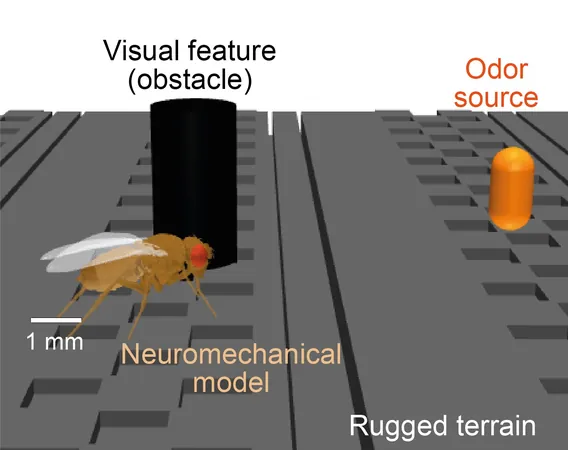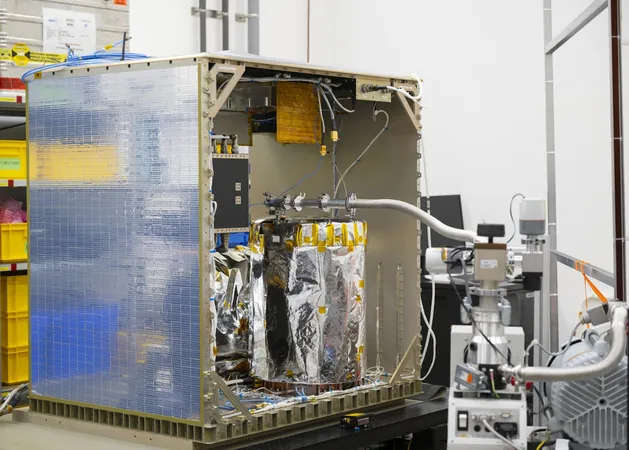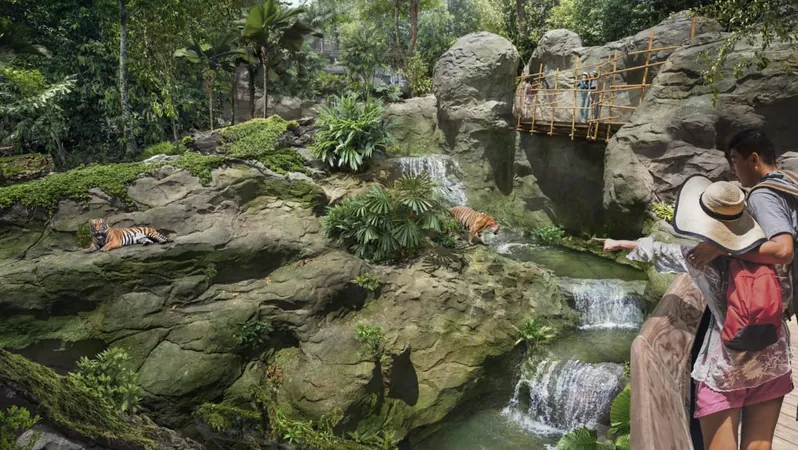
Revolutionary Virtual Model of Fruit Fly Unlocks Secrets of Sensory Navigation!
2024-11-12
Author: Arjun
Introduction
In the intricate world of animal movement, precision is paramount. Every creature, regardless of its size, must master the art of locomotion to effectively interact with its environment. One of the pivotal questions in neuroscience centers on how the brain orchestrates such movements. While studying larger animals presents numerous challenges due to their complex brain structures, scientists have set their sights on the fruit fly, Drosophila melanogaster. With a relatively simple and accessible brain, this tiny insect serves as an ideal model for understanding fundamental neural processes.
Groundbreaking Research
Researchers from Pavan Ramdya's team at the École Polytechnique Fédérale de Lausanne (EPFL) have made groundbreaking strides in this area by creating a virtual reality platform that simulates the behaviors of a fruit fly, enabling it to replicate real-world actions. Their findings were recently published in the prestigious journal Nature Methods.
NeuroMechFly v2 Program
This innovative program, dubbed NeuroMechFly v2, elevates the study of fruit fly behavior beyond mere motor functionalities. By integrating visual and olfactory inputs, accommodating for rugged terrains, and employing intricate motor feedback, the model effectively simulates how fruit flies navigate their surroundings while responding to external stimuli like sights, smells, and obstacles.
Previous Developments
Ramdya's previous work laid the groundwork for this endeavor. In 2019, his team launched DeepFly3D, utilizing deep learning techniques to analyze the movements of fruit fly legs captured by multiple cameras. Following this success, they introduced LiftPose3D in 2021, a method capable of reconstructing 3D poses of the fly from images sourced from a single camera. The culmination of these efforts was marked by the introduction of NeuroMechFly in 2022, which created a visually accurate digital twin of the Drosophila.
Enhanced Model
With the enhancements found in NeuroMechFly v2, the research team incorporated fine details that echo the real anatomy and physiology of fruit flies. The model's leg and joint movements now authentically reflect the biomechanics of actual fruit flies, allowing the virtual creation to respond to sensory inputs through its simulated eyes and antennae, mimicking the sensory experience of a real fly.
Versatile Testing
The versatility of NeuroMechFly v2 allows for the testing of various control strategies in real-life scenarios—ranging from traversing uneven surfaces to being guided by odors and visual information. The researchers successfully demonstrated lifelike behavior as the model adeptly tracked moving objects or sought out sources of scent while evading obstacles along the way.
Understanding Neural Activity
Additionally, this model provides a novel opportunity for scientists to deduce neural activity within the fly's brain based on its virtual experiences. By linking NeuroMechFly v2 with a recent computational framework of the fly's visual system, researchers gain insight into not only what the simulated fly perceives but also how actual neurons might react in similar situations, as explained by lead researcher Sibo Wang-Chen.
Emulating Natural Behaviors
Using this data, the scientists were able to emulate a flying chase, akin to behaviors observed during courtship, grounded in biological realism. The model's hierarchical control system allows interactions between higher-order cognitive functions and simpler motor commands, effectively replicating how real animals coordinate sensory information and motor behavior.
Path Integration Feature
One remarkable feature of NeuroMechFly v2 is its ability to utilize feedback from leg movements to maintain spatial awareness—a behavior known as path integration. This characteristic enables the virtual fly to have a sense of its location, even when visual information is scarce. Closed-loop sensory processing exemplifies the biological intelligence characteristic of many living beings and represents a significant leap forward in neuroengineering.
Implications for Future Research
Overall, NeuroMechFly v2 stands as a powerful tool that allows researchers to delve into the complexities of how the brain governs essential behaviors. This work opens doors to deeper understanding of brain-body dynamics, particularly in species with intricate sensory-motor systems.
Future Applications
Looking ahead, the implications of this model could extend beyond flies, serving as a theoretical framework for designing robotic systems that navigate their environments using sensory inputs, such as tracing scents or stabilizing visuals. By refining machine learning techniques that guide these simulations, researchers aim to harness insights from animal intelligence to develop AI systems that are more autonomous, resilient, and responsive to their surroundings.
Conclusion
With continued advancements, the potential of NeuroMechFly v2 could not only inspire future robotic innovations but also revolutionize our understanding of neural dynamics in living organisms. Get ready to explore how the secrets of the humble fruit fly might just pave the way for a brighter, smarter tomorrow!




 Brasil (PT)
Brasil (PT)
 Canada (EN)
Canada (EN)
 Chile (ES)
Chile (ES)
 España (ES)
España (ES)
 France (FR)
France (FR)
 Hong Kong (EN)
Hong Kong (EN)
 Italia (IT)
Italia (IT)
 日本 (JA)
日本 (JA)
 Magyarország (HU)
Magyarország (HU)
 Norge (NO)
Norge (NO)
 Polska (PL)
Polska (PL)
 Schweiz (DE)
Schweiz (DE)
 Singapore (EN)
Singapore (EN)
 Sverige (SV)
Sverige (SV)
 Suomi (FI)
Suomi (FI)
 Türkiye (TR)
Türkiye (TR)